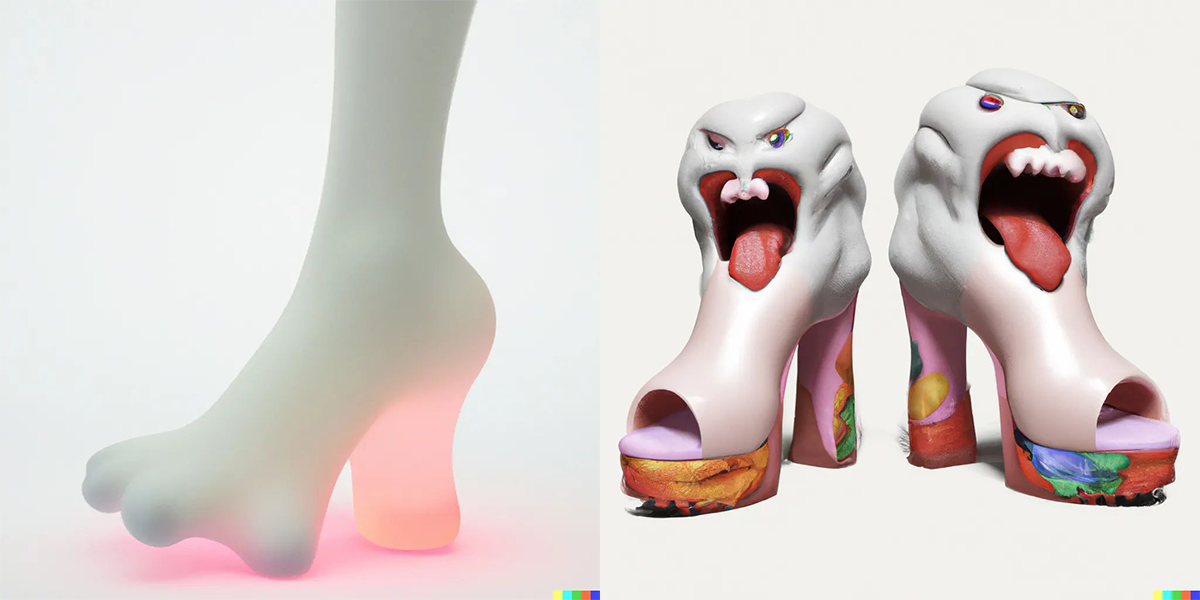How footwear designers like Miguel Peña and AI users can create digitally fabricated fashion concepts through the click of a button.
As an industry founded on creativity and expression, fashion was slow to accept Artificial Intelligence. However as the Metaverse and NFT’s grow and gain investments, designers and high fashion houses are exploring new technologies. Brands like H&M, Tommy Hilfiger, and Zara mainly use AI to predict future trends rather than create unique designs. Through new AI interfaces users and fashion designers alike can create one-of-a-kind digital products just by describing its desired physical attributes. These tools allow people to create compositions without training in fashion design software, drawing, sewing, and any traditional craftsmanship, all while providing experienced fashion designers with new ways to explore advanced concepts in apparel.
In 2021, the research lab OpenAI designed an AI model called DALL-E, which was trained to create specific imagery based on any text description. DALL-E was originally only available to a small number of artists and researchers, however in September OpenAI removed the waitlist for the service, allowing anyone to use it.
Although most fashion houses aren’t exploring these AI Models, individual designers like Miguel Peña are using DALL-E to explore technology’s ability to further self expression. Peña has designed footwear professionally for 5 years, with a portfolio consisting of digitally fabricated footwear that is both performance efficient, innovative, and aesthetically futuristic. In the last two years, his brand has focused on prototyping designs through digital software. Peña’s interest in AI started when he discovered creative workflows using DALL-E on TikTok.
Through AI, Peña can use specific phrases and terms which DALL-E converts into designs. Peña explains further in an interview with Mission, “with the right modifiers in the prompt, I can get close to a visual of what I am trying to express… AI is comparable to a visual stream of consciousness.” The prompts he uses vary with each concept he is trying to achieve, Peña continues, “I have found certain phrases help me find consistency in my results. For example, saying something along the lines of ‘someone wearing a purple sneaker’ has seemed to ground the results in reality much more efficiently than simply saying ‘a purple sneaker.’” By providing specifics of materials, settings, adjectives, and more, Pena can bring the image in his head to life.
Although many of his designs are conceptual, Peña hopes to create physical versions next year. It can only be expected that AI will grow within fashion as it has in other industries. It is, however, not without its controversy. AI works as a quick way to formulate unique compositions, especially for many creatives who don’t have the money or technical skill required for more traditional modes of design. “I am against the idea that design should be privatized by those that can draw, and AI is a solution to that. On the flip side, I think AI can certainly serve as a crutch in certain instances,” Peña explains. Although designers can become reliant upon the software, it can also leave room for unexpected inspiration and perpetuate unique designs. Peña elaborates, “the Instagram footwear design landscape has been interesting in the last few months because while we have this AI tool that should unlock creative opportunities we haven’t had before, there’s still a large number of “yeezys” being created in AI.”
Although AI can create designs, it would not be capable of doing so without prompts imagined and described by the creator. “A designer’s ability to communicate an authentic story through their work is a uniquely human quality. Their style comes from years of experience and fine-tuning their work to create a style and body of work that is uniquely theirs. Construction, craftsmanship, and problem solving are also factors to consider in this context. That said, as machine learning evolves over time, I would be very interested to see what the creative industry looks like and if fashion designers have been replaced by technology or if they evolved along with it,” says Pena.
With more people having access to AI software, it allows almost anyone to create designs with descriptive words and the click of a button, while leaving creatives questioning if their imagination and traditional skills (drawing, sewing) will become obsolete as the technology progresses.
Images courtesy of Miguel Peña





